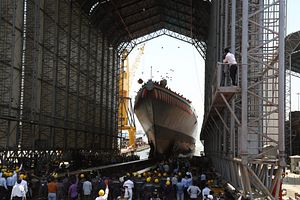State-owned Mazagon Dock Shipbuilders Limited (MDL) has launched India’s third Project 15B Visakhapatnam-class guided-missile destroyer, the future INS Imphal, in Mumbai on April 20, the Indian Ministry of Defense (MoD) said in a statement.
The future INS Imphal is part of a planned fleet of four Visakhapatnam-class surface combatants. The first-of-class Visakhapatnam was launched in April 2015 and is expected to enter service with the Indian Navy in 2021. The second ship of the type, Mormugao, was launched in September 2016 and is slated to join the fleet in 2022. The third and fourth Visakhapatnam-class guided missile destroyers are expected to enter service in 2023 and 2024 respectively.
Designed by the Indian Navy’s Directorate of Naval Design, the Visakhapatnam-class is based on the older Project 15A Kolkata-class destroyers design with Russia’s Northern Design Bureau, enlisted as a consultant, to help reduce the size of the ship’s superstructure. Displacing 7,300 tons, ships of the class are powered by four Ukrainian-made gas turbine engines, and capable of reaching speeds in excess of 30 knots. Around 65 percent of components of the Vishakhapatnam-class are domestically designed and produced, including 11 of its weapon and associated sensor systems, according to Indian naval officials.
“These ships are packed with an array of state-of-the-art weapons and sensors, including multi-functional surveillance radars and vertically launched missile system for long distance engagement of shore, sea-based and air targets,” the April 20 MoD statement reads. “With significant indigenous content, these ships are a true hallmark of self-reliance attained by our country in warship design and shipbuilding, and a shining example of the ‘Make in India’ philosophy.”
Notably, the Visakhapatnam-class will be capable of firing the sea-launched variant of the BrahMos supersonic cruise missile, a derivative of the Russian P-800 Oniks over-the-horizon supersonic anti-ship cruise missile, from its two eight-cell vertical launch systems (VLS). Additionally, I explained:
[T]he ships will be equipped with the Barak-8/NG — an Indo-Israeli surface-to-air missile (SAM) — jointly developed by Rafael-IAI and the DRDO. The weapon was successfully tested in Israel in November 2014. The Visakhapatnam can carry up to 32 of these medium-long range air defense missiles.
Furthermore, the ship boasts a license-built 76 mm Oto Melara Super Rapid Gun, four fully-automated Russian AK-630 close-in weapon systems (likely fitted on the vessel’s bow), and a yet-to-be-selected 127 mm gun (however, local media sources claim that the ship will just be armed with a 127 mm main gun instead of a 76 mm Super Rapid Gun Mount).
The Multi-Function Surveillance Threat Alert Radar (MF-STAR) is the Israeli equivalent to the U.S. Navy’s Aegis Combat System and allegedly on par with the Chinese “Aegis” system installed on the Type 052D Multirole Destroyer.
For antisubmarine warfare, the new stealth guided-missile destroyer features twin-tube launchers and RBU-6000 Smerch-2 rocket launchers. It can also carry two multiple-role helicopters (e.g., Sea King or HAL Dhruv helicopters).
Each ship of the class will have a complement of 50 officers and 250 sailors. Total program costs are expected to exceed $5 billion.

































